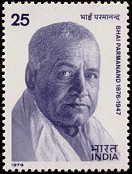Bhai Parmanand

Bhai Parmanand (4 November 1876 – 8 December 1947) was an Arya Samajist.
Early life
Parmanand was born into a prominent family of the Punjab, descended from the family of the famous Sikh martyr, Bhai Mati Das.[1] His father, Bhai Tara Chand Mohyal, came from Kariala, Jhelum District and was an active religious missionary with the Arya Samaj and one-time President of the Hindu Mahasabha.
Following the British announcement of the partition of Bengal (1905), he demanded that 'the territory beyond Sindh should be united with Afghanistan and North-West Frontier Province into a great Musulman Kingdom. The Hindus of the region should come away, while at the same time the Musulmans in the rest of the country should go and settle in this territory'. This preceded the Muslim League's Pakistan Resolution by over three decades.
Visit to South Africa
In October 1905, Parmanand visited South Africa and stayed with Mahatma Gandhi as a vedic missionary. Parmanand visited Guyana in 1910 which was the centre of the Arya Samaj movement in the Caribbean.[2] His lectures increased their following there. In 1911, he visited Lala Hardayal when he was on retreat in Martinique. Parmanand persuaded Hardayal to go to the United States to found a centre for the propagation of the ancient culture of the Aryan Race. Hardayal left for America, but soon located himself in Hawaii, where he again went on retreat on Waikiki Beach. A letter from Parmanand prompted his departure for San Francisco where he became an activist in the anarchist movement.
Visit to South America
Parmanand toured several British colonies in South America before rejoining Hardayal in San Francisco. He was a founder member of the Ghadar Party. He accompanied Hardayal on a speaking tour to Portland in 1914 and wrote a book for the Ghadar Party called Tarikh-I-Hind. He returned to India as part of the Ghadar Conspiracy claiming he was accompanied by 5,000 Ghadarites. He was part of the leadership of the revolt, and was sent to promote the revolt in Peshawar. He was arrested in connection with the First Lahore Conspiracy Case and was sentenced to death in 1915. The sentence was later commuted to one of transportation for life: he was imprisoned in the Andaman Islands until 1920 and subjected to hard labour. In protest against such harsh treatment of political prisoners, Bhai Parmanand went on hunger strike for two months. The King-Emperor, George V, released him in 1920 as the result of a general amnesty order.[3]
In 1930, he was the chair of the Sind Provincial Hindu Conference, where he expressed concern that Muslim creation of Pakistan would divide India. He met Gandhi again in 1933 where he analysed India as being composed of three elements: Hindus, Muslims and the British. He suggested that Gandhi had tried to bring the first two together to drive out the British, but that the British had succeeded in gaining the support of the Muslims. Gandhi replied that he was an optimist, and look forward to the day when Muslims would join with Hindus. Parmanand suggested that only if Hindus organised amongst themselves would Muslims join them as nobody associates with the weak.
Death
Parmanand died on 8 December 1947 of a heart attack. He was survived by his son Dr. Bhai Mahavir, who rose to be a prominent member of the Jana Sangh and BJP.
Honour
An Institute of Business Studies was named after him in New Delhi. A Public School in East Delhi and also an hospital bear his name in Delhi.
Writings about Jats
Bhai Parmanand wrote in "Panjab Tarikh" about Jats - “एक शब्द में इतना कह देना जरूरी है कि पंजाब में खालसा राज्य स्थापित करके सीमा-प्रान्त की तमाम पठान जातियों को अपने अधीन करना और अफ़गानिस्तान के पठानों को कई बार हरा देना, जो कि हमारी जाति के इतिहास में अचम्भा समझा जाता है, जाट जाति के वीरों का ही काम था। इस देश में क्षत्रिय के कर्त्तव्य का जाटों ने यदि राजपूतों से बढ़कर नहीं तो कम भी पालन नहीं किया है।”[4]
References
- ↑ Singh, Fauja (1972). Eminent Freedom Fighters of Punjab. Punjabi University, Dept. of Punjab Historical Studies.
- ↑ Lal, Prita (1 May 2005). Hinduism Here "Arya Spiritual Center"
- ↑ Singh, Jaspal. "Historical Sikh Events: History of the Ghadar Movement part 3 - Return to India". All About Sikhs.
- ↑ Jat History Dalip Singh Ahlawat/Chapter II (Page 150)
Back to Arya Samaj

